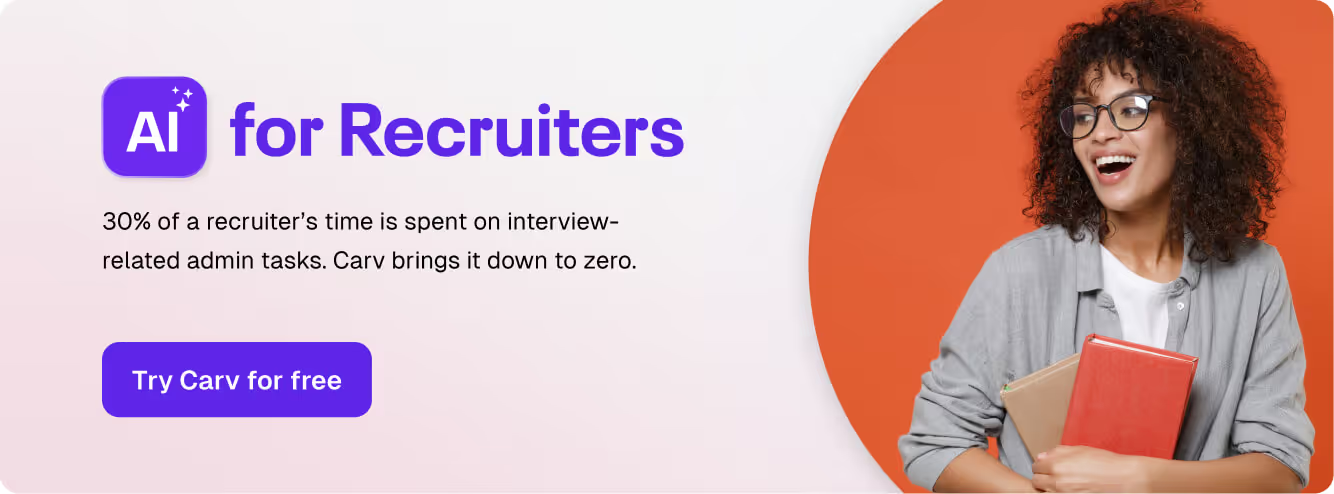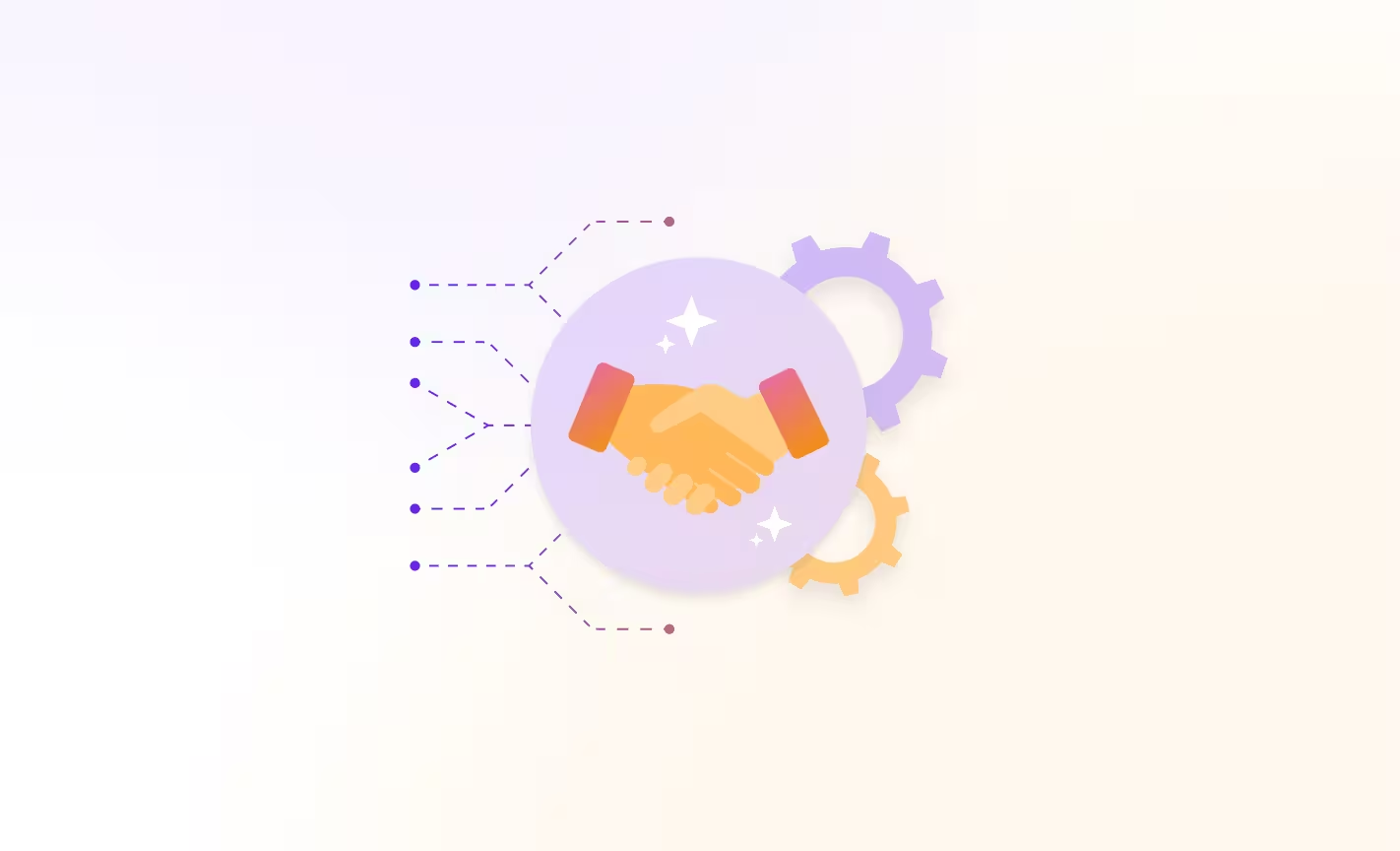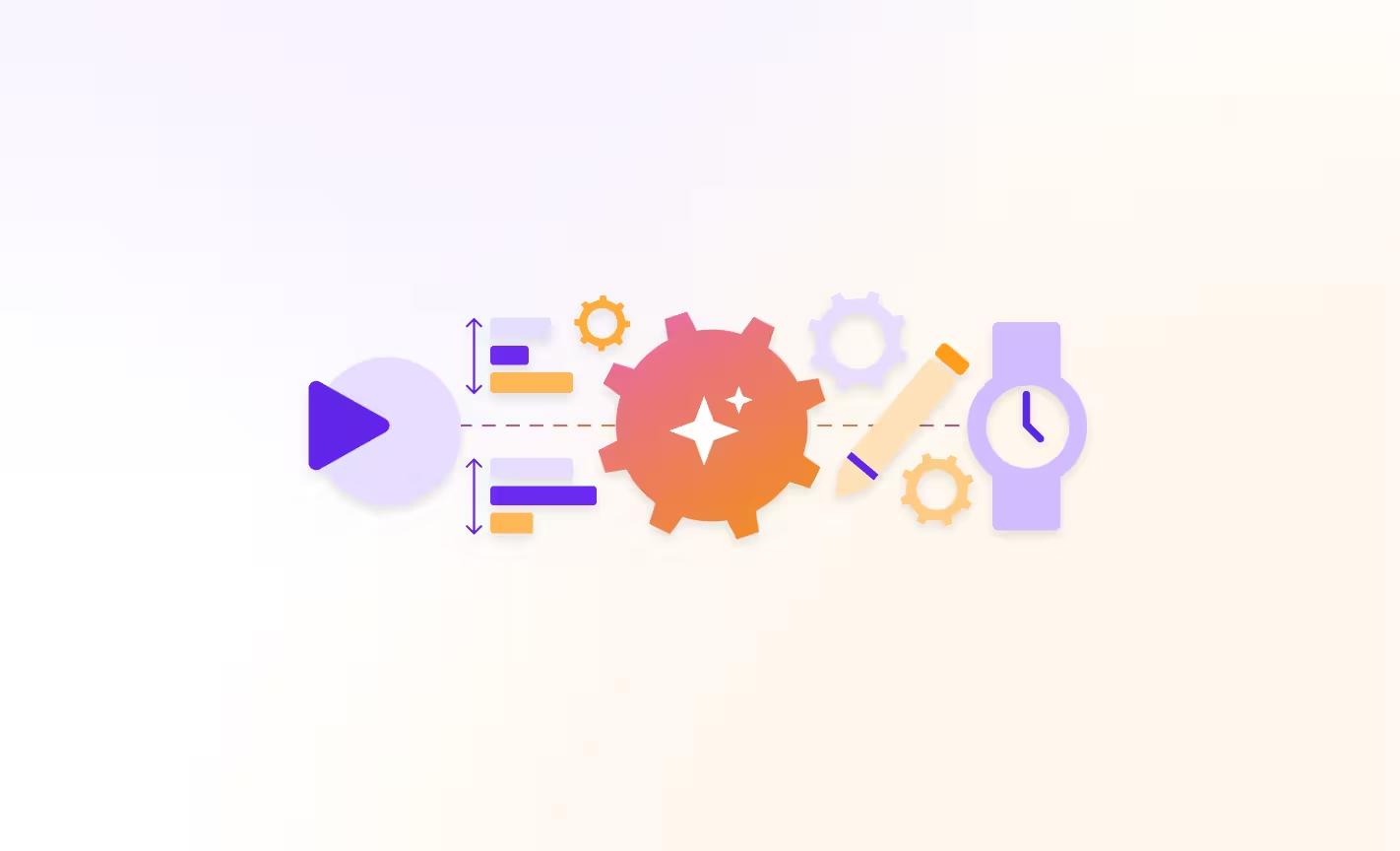Interviews come in three flavors: structured, unstructured, and semi-structured. Each of these interview formats serves different purposes and offers unique benefits, and selecting the appropriate type of interview depends on the end goal and stage in the hiring process.
Once these are in alignment, interviewers can ensure a sharpened interview process for shortlisting the best candidates.
In this article, we’ll explore the differences between these types of interview, identify which interview stages are best suited for each of them, and how Carv’s AI can support you and your TA team throughout the interview process.
Structured interviews - Overview
First of the exploration of this interview-triptych, are structured interviews.
A structured interview involves predetermined interview questions asked in a standardized interview, ensuring consistency and easy comparison of different candidates.
Every interviewee gets the same set of questions (close-ended questions or multiple-choice questions), in the same order, which will bring the following advantages to the interview-table:
- Consistency: Every interviewee is evaluated using identical criteria.
- Easy comparison: Standardized questions simplify comparing candidate’s answers.
- Less bias: Uniform questions help reduce interviewer bias.
- Specific-skills questionnaire: Ideal for evaluating specific knowledge or skills.
Nevertheless, this type of interview does comes with a cost.
- Rigidity: One of the disadvantages of structured interviews, is its limited room to dive deeper into responses.
- Limited exploration: Additionally, there's less flexibility to deviate from set questions.
Now that the pros and cons of this type of interview are clear, let’s see when it’s best to use structured questions, and how AI can help you speed up the interview preparation process.
Example questions for structured interviews
In general, given the nature of the questions, structured interviews are best suited for early screening stages that focus on specific skills and knowledge.
Here are some examples of questions you might find in a structured interview, depending on the job being filled:
- Experience: "Can you tell me about a time you had to meet a tight deadline on a project?". This could be a behavioral question asking the candidate to describe a past situation
- Skills: "What is your experience with [specific software program]?". This is a knowledge-based question testing the candidate's technical skills
- Situational Judgment: "If you saw a colleague violating company policy, what would you do?". This assesses the candidate's judgment and problem-solving skills in a work scenario
Close-ended questions: These questions have a limited set of possible answers, making them easy to evaluate and compare across candidates.
- "Do you have a valid driver's license?" (Yes/No)
- "On a scale of 1 to 5, how comfortable are you using public speaking software?" (1-5 rating)
Multiple-choice questions: These questions offer a set of answer options, allowing for quick selection by the candidate.
- Which of the following best describes your communication style?
- (a) Direct and assertive
- (b) Collaborative and team-oriented
- (c) Creative and persuasive
Remember: Structured interviews are typically used to assess basic qualifications and narrow down a large pool of applicants. They are less effective for exploring a candidate's personality, soft skills, or their fit with the company culture.
How to prepare a structured interview with Carv
If you want to use a structured interview, Carv can help you tie the interview together.
While structured interviews stick to a structured format, Carv can suggest follow-up questions based on candidate’s answers, to add depth to the interview style, and offer customizable interview templates.
Also, Carv can debrief calls and manage follow-ups with candidates and hiring managers for a seamless hiring process.

Unstructured interviews - Overview
This type of interviews are like open-ended conversations. With just a few predetermined questions a more natural flow emerges, allowing you as the interviewer to be guided by the candidate's answers, and explore different questions based on their responses.
Advantages of unstructured interviews:
- Exploring experiences: Unstructured interviews offer deeper insights into a candidate's background and experiences.
- Personality and culture-fit assessment: These types of job interviews help gauge how well a candidate fits within the company culture.
- Flexibility: Unstructured interviews allow interviewers to have an open interview style and dive into interesting topics as they arise.
This type of interview too, isn’t without any perils.
Cons:
- Inconsistency: One of the disadvantages of unstructured interviews is their lack of standardization. Unstructured interview questions can lead to varied candidates answers and experiences.
- Difficult comparison of answers: Meaning, without structured format, varied responses make comparison challenging.
- More bias: Unstructured interviews have greater potential for interviewer bias due to lack of structure.
Example questions for unstructured interviews
Considering the benefits and implications, unstructured interviews are best suited for later stages of the hiring process, where understanding the background and cultural fit of different candidates is crucial.
Here are some examples to get you started:
Open-ended questions: These encourage detailed responses and provide insights into the candidate's personality, motivations, and problem-solving skills.
- "Tell me about a time you had to overcome a significant challenge."
- "What are your career aspirations, and how does this position fit into your long-term goals?"
- "Describe a situation where you had to use your creativity to solve a problem."
Behavioral questions: These ask the candidate to describe past experiences that reveal their approach to work-related situations.
- "Can you give an example of a time you demonstrated strong leadership skills?"
- "Tell me about a project you're particularly proud of and your role in its success."
- "Describe a situation where you had to work effectively under pressure."
Hypothetical questions: These assess a candidate's critical thinking and decision-making abilities.
- "How would you approach a situation where you had to deal with a difficult client?"
- "Imagine you have a limited budget to complete a crucial project; how would you allocate resources?"
- "If you could implement one change to improve this department, what would it be?"
Remember: Unstructured interviews require active listening and follow-up questions to gain a well-rounded understanding of the candidate. This approach allows you to assess their fit for the company culture and explore their potential for future growth within the organization.
How to prepare an unstructured interview with Carv
Carv can be your go-to tool for unstructured interviews. It suggests relevant questions and topics for you, can create conversation reports, and facilitate follow-ups to ensure you capture valuable insights.
Also, due to its ability to record and analyze interviews —both virtual and in-person—it will capture valuable insights that you might miss during the interview itself. Carv can analyze body language, tone, or overall interview sentiment to, let’s say, tell you about the general attitude of the candidate.
Although biases can still be present, using AI for preparing questions and evaluating candidate responses ensures an overall more objective evaluation and consistent questioning techniques.

Semi-structured interviews - Overview
In this type of interview structured and unstructured interview styles are blended together. The interview format includes predetermined and standardized questions, and allow for a free flow and open follow-up questions too.
Advantages of semi-structured interviews
- Combination of benefits: Semi-structured interviews merge the consistency of structured interviews while maintaining the depth of unstructured ones.
- Key skills assessment: This format ensures key areas are addressed through a predetermined set of questions.
- Deeper exploration: Yet, it offers flexibility to delve deeper based on candidate’s answers.
Does this interview format equal only fruits? Well:
Cons:
- Required interviewer skills: Success of semi-structured interviews still relies on the interviewer's ability to balance structure and flexibility.
- Potential bias: Therefore, if not carefully managed, bias can still creep in.
Albeit these possible cons, semi-structured interviews can fit all stages of the recruitment process. The reason is simple: this type of interview offers flexibility while ensuring that key areas are covered.
Example questions for semi-structured interviews
Semi-structured interviews combine the strengths of both structured and unstructured formats.
They offer a predefined list of core questions to ensure consistency, while also allowing for flexibility to explore interesting answers and delve deeper into specific aspects of a candidate's background.
Here are some examples:
Core questions (similar to structured interviews):
- These questions establish basic qualifications and knowledge relevant to the position.
- You can use a mix of close-ended, multiple-choice, or open-ended questions depending on the information you seek.
- "What is your experience with [specific software program]?" (Knowledge-based)
- "On a scale of 1 to 5, how comfortable are you working independently?" (Rating)
Open-ended questions:
- These follow-up questions build upon the candidate's responses to core questions, encouraging them to elaborate and showcase their thought process.
- "Tell me more about how you tackled that challenging project." (Following up on a success story)
- "Why did you choose that particular approach in that situation?" (Probing a problem-solving experience)
Situational follow-ups:
- These questions explore the candidate's behavior and decision-making within a hypothetical scenario. This allows you to assess their approach to real-world situations relevant to the job.
- "How would you prioritize tasks if you were faced with multiple deadlines?" (Following up on a time management experience)
- "What steps would you take to build rapport with a new team?" (Probing a teamwork scenario)
Remember: Semi-structured interviews require a balance between following the core question list and actively listening to the candidate's responses.
Be prepared to adapt your follow-up questions based on their answers, allowing for a natural flow of conversation while still gathering necessary information. This approach helps you assess both the candidate's qualifications and their potential fit within your organization.
How to prepare a semi-structured interview with Carv
Carv can be your right hand throughout the interview process every step of the way, enhancing fairness and overall quality of your hiring process.
The AI can analyze a job candidate’s complete profile, including professional history and online presence, such as LinkedIn, to assess cultural fit and predict long-term performance and retention without bias. This comprehensive approach ensures you make the best decisions in the hiring process and find the best candidates time and time again.
Based on candidate data and using past conversations - for example, screening calls or past interviews, Carv can generate a mix of standardized questions and open-ended follow-up suggestions, ensuring a thorough candidate evaluation wherein structure and flexibility are managed.
Moreover, you can use Carv for AI-driven insights and interview feedback, ensuring you cover all essential areas while remaining flexible, and continually monitor your interview process for potential biases.

Choosing the right interview format
As we initially wrote, choosing the most suitable interview style depends on the end goal. Lets take you through the interview process, and the right ways to steer the interview-weel through every stage.
- Initial screening: For initial screenings, assess to basic qualifications and skills are essential. Structured interviews are your go-to-interview here, since they efficiently take you through a standardized set of questions and anwers, ensuring efficiency and consistency.
- In-depth interview: In this phase, it’s all about the balance between structure and exploration of candidate persona. Semi-structured interviews will let you benefit from both, since it covers standardized interview questions as well as open-ended questions and follow-ups, that will gauge cultural fit and problem-solving abilities.
- Final round: All we need in this stage are the exploration of experiences, personality and culture fit, and flexiblity, since the understanding of job candidate’s character and adaptability is paramount. Unstructured interviews are opt for this stage therefore, giving you assess to culture fit and overall suitabilty.
Carv can streamline your entire interview process from initial screening to the final showdown.
It will assist with pre-screening interviews, ensuring a consistent baseline for all candidates, and will help you prepare and debrief interviews, create reports, and facilitate follow-ups with candidates and hiring managers.
Additionally, it can support with data collection and data analysis to help you better assess respondents and identify ideal candidates, as well as eliminate potential unconscious bias in the selection process.
Over to you
Tailoring your interview style to the phase, objectives, and desired candidate persona of the hiring process, is like the secret sauce for retaining and nurturing the best candidates. The right format at the right moment will reveal invaluable insights into a job candidate's fit and potential.
Yet, no matter the format: equally important is the interviewer. Therefore, training is another main ingredient in refining your interview process, to minimize bias and ensure a fair evaluation process.
You, as a Human Resources professional, must be adept at asking the right types of questions and interpreting qualitative data.
Tools like Carv can support your journey.
At Carv, we understand the complexities of the hiring process and provide tools to streamline and enhance your interviews.
For example, you can experiment with structured, unstructured, and semi-structured interviews in Carv using the mock interview and intake call available in the platform. Just sign up for free, and ask your AI workmate to prepare each of these interview types for you.

.avif)

.avif)




